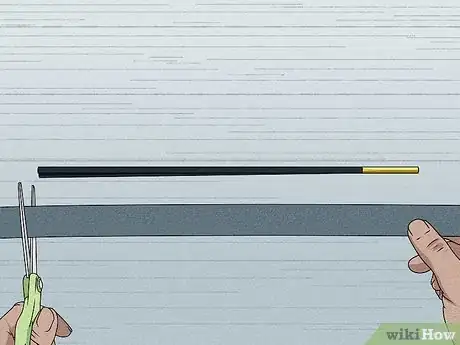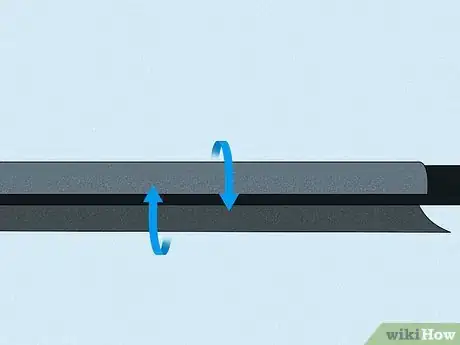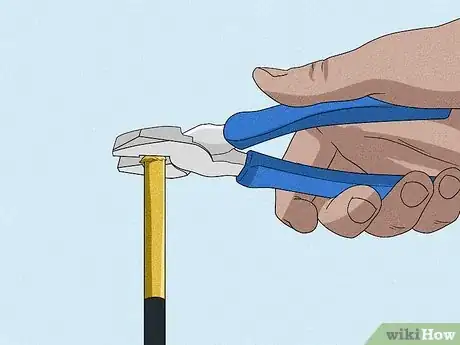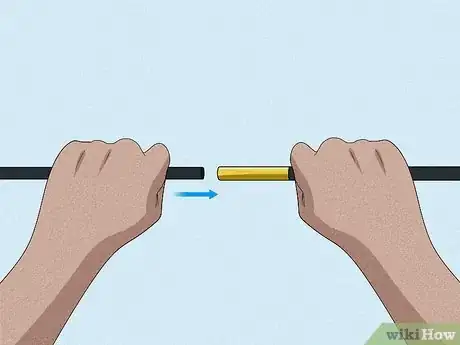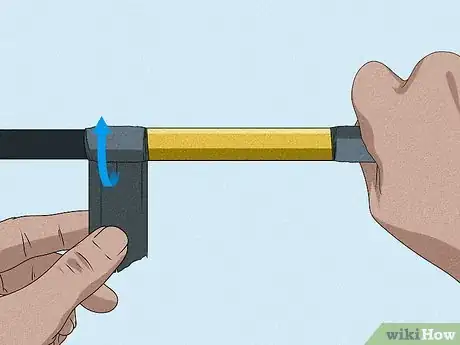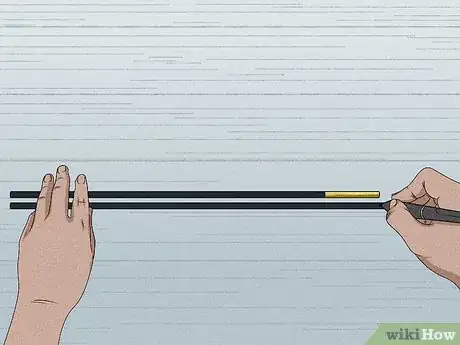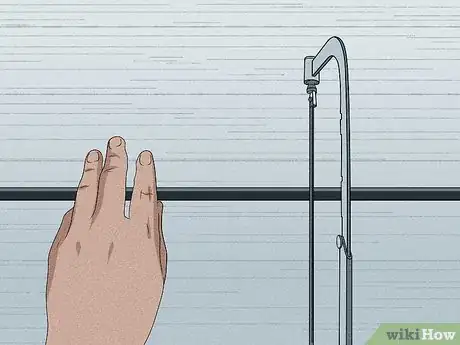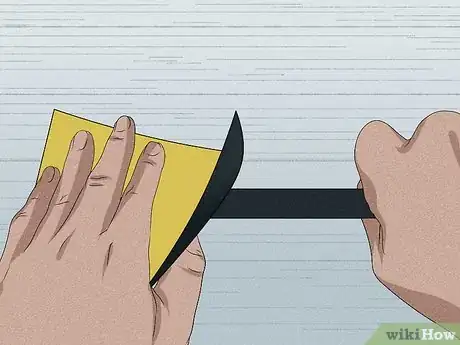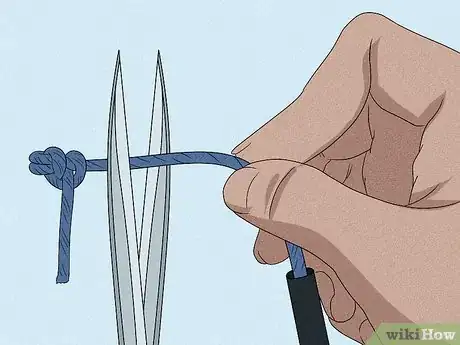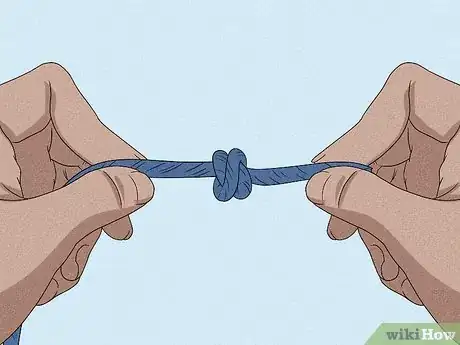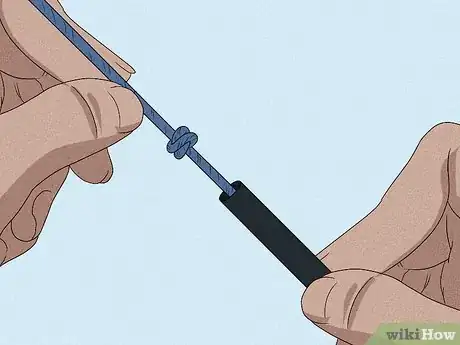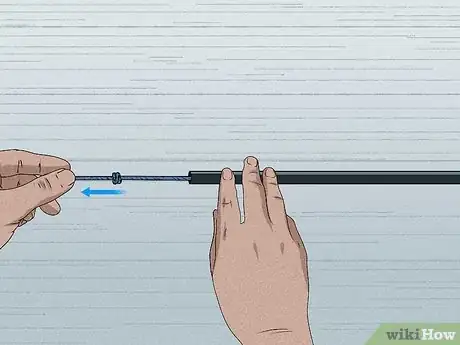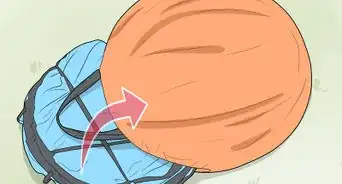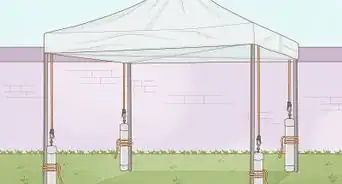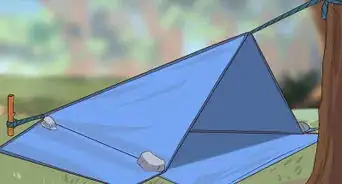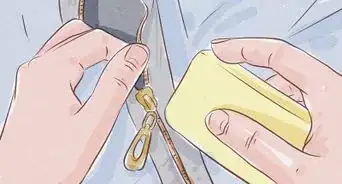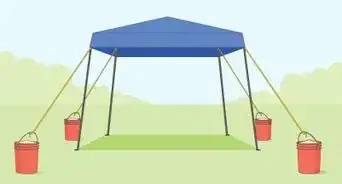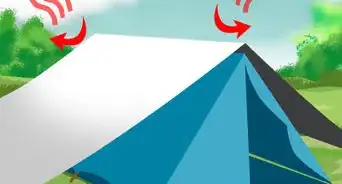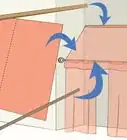This article was co-authored by wikiHow Staff. Our trained team of editors and researchers validate articles for accuracy and comprehensiveness. wikiHow's Content Management Team carefully monitors the work from our editorial staff to ensure that each article is backed by trusted research and meets our high quality standards.
There are 22 references cited in this article, which can be found at the bottom of the page.
This article has been viewed 16,680 times.
Learn more...
A broken tent pole could cause your hopes for a perfect camping trip to come crashing down around you—literally. Unless you know how to perform a few basic repairs, that is. Whether you’re taping up a pole that’s split down the middle, reinforcing a broken segment, or replacing a worn out shock cord, a few inexpensive, readily-available materials will have you back in the comfort and safety of your faithful shelter in minutes.
Steps
Taping a Split
-
1Lay the damaged pole out on a flat surface. A portable camping table or picnic table will be ideal for this purpose. If you don’t have access to either of these furnishings, set the pole on top of a flat piece of gear, such as a cooler or toolbox. A smooth rock or level stretch of ground will also work in the worst-case scenario.[1]
- There’s no need to disassemble the pole or remove the elastic shock cord that holds it together.
- Take a moment to clear your work surface of leaves, twigs, pine needles, sand, and similar debris. If these items find their way onto your tape, they could compromise its ability to stick properly.
-
2Tear off a strip of gaffer’s tape the same length as the split segment. To determine how long a strip you need, line up the loose end of the tape with the extreme end of the segment, then unspool the roll slowly until you reach the far end. Tear the tape as cleanly as possible to ensure that both ends are nice and square.[2]
- Gaffer’s tape is a type of heavy-duty, high-strength tape commonly used to repair electronics and mechanical components. You can pick up a roll at any hardware store or home improvement center for just a few dollars.[3]
- If you didn’t happen to pack any gaffer’s tape, an ordinary roll of duct tape will also do the trick.
Tip: This quick, no-frills fix is best suited for emergency situations, like when you have a pole split on you when you’re already out in the wilderness.
Advertisement -
3Press the lateral edge of the tape into place over the split. Cover the entire length of the split with 1⁄4–1⁄2 inch (0.64–1.27 cm) of tape. This will leave you with 1⁄2–1 1⁄2 inches (1.3–3.8 cm) of reinforcement, depending on the width of the roll you’re working with.[4]
- Taping a split lengthwise is far more effective than simply wrapping the ends. The more surface area the tape has to cling to, the more firmly it will clamp the split together.
-
4Continue wrapping the tape all the way around the split. Fold the tape carefully to avoid leaving wrinkles or creases. Once you’ve got the entire strip in place, use the pads of your fingers to smooth it down. You can now resume setting up your tent without any further worries![5]
- By wrapping the tape this way, you’ll overlap the split itself at least twice while also binding the rest of its length.
- Provided you use the right kind of tape and wrap your pole good and tight, it should hold up for the remainder of the season, if not longer.[6]
Splinting a Break
-
1Trim or break off the jagged edges around the break, if necessary. Use wire cutters to remove any shards or splinters you see sticking out beyond the shaft of the segment, or work them loose with a pair of pliers. This will give the affected site a uniform thickness and prevent the rough edges from doing further damage.[7]
- You may also need to bend aluminum poles back into shape by hand to get them to fit inside the tent pole repair sleeves you’ll be using. Many aluminum tent poles can be bent by hand, but if you have difficulty, you can try using an arbor press in the same way you'd bend small aluminum sheet scraps.
-
2Slide a tent pole repair sleeve over the damaged segment. Extend the pole as straight as you can and slip the tubular sleeve over one end. Guide the sleeve along the length of the pole until it covers the break. For best and longest-lasting results, make sure it’s centered as evenly as possible.[8]
- Most new tents come with at least one repair sleeve for convenient fixes in the field. These are typically made from ultra-strong aluminum alloy, which makes for a durable yet lightweight splint.
- If you don’t have a repair sleeve at the ready, a tent stake or sturdy stick can serve as an acceptable substitute.[9]
Tip: While it’s not necessary to take the pole apart in order to maneuver the sleeve into place, it may be easier to do so.
-
3Secure the ends of the sleeve with duct or gaffer’s tape. Tear off a couple 4–6 in (10–15 cm) strips of tape and wind them around the points on the pole where they emerge from the sleeve’s outer edges. After applying the tape, you’ll be able to put up or pack your tent as you normally would, knowing that the splint will act to brace the break.[10]
- Feel free to wrap the tape as many times as you see fit to be extra certain that the sleeve stays put. You can even go over the entire sleeve, if you like.
- Although the average tent pole repair sleeve is tough enough to endure multiple camping seasons, it’s still a good idea to track down a replacement pole at your earliest convenience.[11]
Replacing an Entire Pole Segment
-
1Find a replacement segment that's the same size as the damaged pole. Some tent manufacturers package their products with replacement parts, including poles and pole segments. If your tent didn’t throw in any spare parts, you’ll need to order a new segment from the original manufacturer. Be sure to measure across the opening of one of the old segments to make sure you’re getting one with the right dimensions.[12]
- You may also be able to track down an individual pole segment that suits your needs from a website or retailer that deals in used outdoor gear.
- Replacement tent pole segments are typically made much longer than standard segments, which allows them to be cut to size easily.[13]
-
2Measure and mark the new segment to match the length of the old one. Rest the two segments side-by-side on a flat surface with their bottom edges aligned. Use a felt-tipped marker to draw a thin line on the shaft of the new segment where the old segment ends. This line will indicate where you’ll be making the necessary modifications to the new segment.[14]
- Alternatively, you can use a piece of contrasting masking or painter’s tape around the segment to mark your cut line. Cutting through the tape as opposed to the unprotected shaft may also help prevent cracking or splitting if your poles are made from fiberglass.
- Don’t stress about being perfectly precise here. As long as your replacement segment is approximately the same length as the old one, it will function just fine.
-
3Cut the segment to size using a hacksaw. Position the pole piece at the edge of your work surface so that the section containing the mark you just made extends out beyond it. Then, grab your hacksaw and glide the teeth back and forth over the line using smooth strokes and steady, moderate pressure. Keep sawing until you make it all the way through the segment.[15]
- Hold the opposite end of the segment firmly with your free hand to keep it from moving around unexpectedly while you’re trying to focus on sawing.
- Be careful when wielding your hacksaw. They’re not especially dangerous tools, but an accident could still happen if you’re not paying attention to what you’re doing.[16]
Tip: A compact hacksaw can make an extremely useful addition to your camping equipment, if you don’t pack one already.
-
4File or sand the cut end of the new segment to smooth out the sharp edges. Once you’ve trimmed the piece to the appropriate length, all that’s left to do is go over the new opening with a metal file or sheet of medium-grit sandpaper. A light buffing will keep the fresh cut from fraying the elastic shock cord that holds the pole together.[17]
- A sandpaper with a grit somewhere between 80 and 120 will work best for this task.[18]
Installing a New Shock Cord
-
1Cut the anchor knot on either end of the pole to remove the old cord. Insert a pair of needle-nose pliers into the open end of the pole to fish out the knot. Use a sharp knife or pair of scissors to cut the cord just below the knot and snake it out of the jointed pole segments.[19]
- Be careful not to lose any of the loose pole segments when you pull the cord out. They’re cylindrical, which means they’ll be prone to rolling.
- This is a good time to replace any pole segments that are worse for wear, since you’ll be disassembling the pole to install the new shock cord anyway.
Tip: Number the pole segments with a felt-tipped marker, starting with the end you cut. This will make it a breeze to put them all back together in the correct configuration later on.[20]
-
2Tie a knot in one end of the replacement cord to anchor it. No need to get fancy—just pick a point 4–6 inches (10–15 cm) from the end of the cord and loop it into a simple double overhand knot. Afterwards, give the knot a couple hard tugs to confirm that it’s tight.[21]
- If you like, you can slide a steel washer onto the section where you plan on tying your knot. The circular washer will give the cord something to bite into and increase the durability of the finished knot.[22]
- Securing one end of the cord before you work it through the many segments that make up the pole will keep it from pulling out accidentally.
-
3Thread the new cord through each of your pole segments. The easiest way to do this is to run the cord through each segment one-by-one, then cinch them all together when you’re done. When you buy a replacement shock cord, it will usually come with an attachable wire pull-through device to help speed up the process a bit.[23]
- It may help to have an assistant hold each segment for you while you concentrate on pushing the cord through, or vice-versa.
-
4Tie off the other end of the cord with the pole extended to its full length. Once you’ve run the new cord through each segment, lay the entire assembly out on the ground. Stretch the cord to create some tension and twist up a second double overhand knot 4–6 inches (10–15 cm) from the end opposite the one you started on. It’s as simple as that![24]
- Don’t forget to slip a second washer onto the cord before tying your final knot if you used one on the first side.
- If your shock cords are fastened with metal pull tips rather than anchor knots, be sure to reinstall them according to the manufacturer’s instructions.[25]
Things You’ll Need
Taping a Split
- Gaffer’s tape
- Duct tape (optional)
- Flat surface
Splinting a Break
- Tent pole repair sleeve
- Gaffer’s tape or duct tape
- Wire cutters or pliers (optional)
- Tent stake or sturdy stick (optional—for makeshift splint)
Replacing an Entire Pole Segment
- Replacement pole segment
- Felt-tipped marker
- Hacksaw
- Metal file or medium-grit sandpaper
- Contrasting tape (optional)
Installing a New Shock Cord
- Replacement shock cord
- Sharp knife or scissors
- Steel washer (optional)
- Replacement pole segment (optional)
- Hacksaw (optional)
- File or sandpaper (optional)
- Felt-tipped marker (optional)
References
- ↑ https://www.youtube.com/watch?v=uzDmEieZ7cs&feature=youtu.be&t=42
- ↑ https://outsider.ie/lifestyle/gaffer-tape-uses/
- ↑ https://www.rvtravel.com/gaffer-tape-could-replace-duct-tape-in-your-repair-kit/
- ↑ https://www.youtube.com/watch?v=uzDmEieZ7cs&feature=youtu.be&t=54
- ↑ https://www.youtube.com/watch?v=uzDmEieZ7cs&feature=youtu.be&t=76
- ↑ https://www.getoutwiththekids.co.uk/camping/camping-tips/tent-spares-and-finding-replacement-parts/
- ↑ https://www.youtube.com/watch?v=VwWPsxjBnzk&feature=youtu.be&t=17
- ↑ https://www.youtube.com/watch?v=ZfpJ7ADrk8Q&feature=youtu.be&t=10
- ↑ https://www.youtube.com/watch?v=ZY0HLrB0xCw&feature=youtu.be&t=112
- ↑ https://www.youtube.com/watch?v=ZfpJ7ADrk8Q&feature=youtu.be&t=27
- ↑ https://boyslife.org/outdoors/ask-the-gear-guy/23431/how-to-replace-a-broken-tent-pole/
- ↑ https://boyslife.org/outdoors/ask-the-gear-guy/23431/how-to-replace-a-broken-tent-pole/
- ↑ https://www.getoutwiththekids.co.uk/camping/camping-tips/tent-spares-and-finding-replacement-parts/
- ↑ https://youtu.be/nZoX-uOKoSw?t=73
- ↑ https://www.youtube.com/watch?v=Ouw8PZG-ajI&feature=youtu.be&t=31
- ↑ http://safety.ucanr.edu/files/1495.pdf
- ↑ https://www.youtube.com/watch?v=uzDmEieZ7cs&feature=youtu.be&t=158
- ↑ https://www.bobvila.com/articles/2145-quick-tip-choosing-sandpaper/
- ↑ https://www.youtube.com/watch?v=uzDmEieZ7cs&feature=youtu.be&t=108
- ↑ https://www.youtube.com/watch?v=ZfpJ7ADrk8Q&feature=youtu.be&t=73
- ↑ https://www.youtube.com/watch?v=7Eso8q84aCc&feature=youtu.be&t=10
- ↑ https://www.coghlans.com/files/0194-Instructions.pdf
- ↑ https://www.getoutwiththekids.co.uk/camping/camping-tips/tent-spares-and-finding-replacement-parts/
- ↑ https://www.youtube.com/watch?v=uzDmEieZ7cs&feature=youtu.be&t=264
- ↑ https://www.youtube.com/watch?v=ZfpJ7ADrk8Q&feature=youtu.be&t=119

